Atelier d’Ora was one of the most important Austrian photo salons of the first decades of the 20th century. The studio was founded in 1907 by Dora Kallmus with the support of Arthur Benda, who was the technical director. Kallmus, who took the pseudonym Madame d’Ora in 1907, quickly became with her studio one of the most sought-after of Vienna's society photographers. She also portrayed many European film stars in her Vienna salon and from 1925 on also in her second studio in Paris.
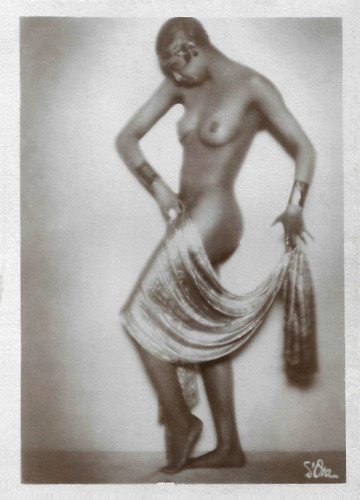
Small French card by Columbia. Photo: d'Ora.
Josephine Baker (1906-1975) was well-known as a singer and dancer. In 1925 she became an instant success in Paris, because of her erotic dance. She also performed in a handful of silent and early sound films, La Sirene des Tropiques (1927), Zouzou (1934), and La princesse TamTam (1935).
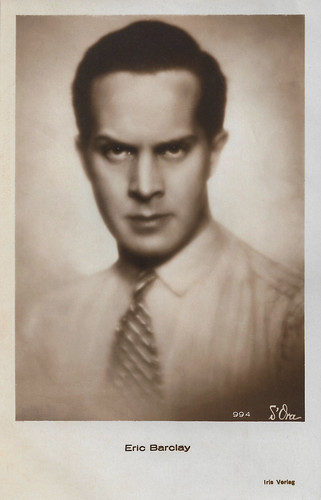
Austrian postcard by Iris Verlag, no. 994. Photo: d'Ora.
Eric Barclay (1894-1938) was a Swedish film actor. Barclay became a prominent actor in French silent films of the early 1920s, often working with director Jacques de Baroncelli. He also appeared in German and British films and those of his native Sweden.
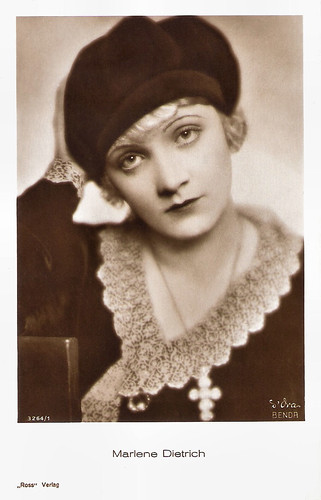
German postcard by Ross Verlag, no. 3264/1, 1928-1929. Photo: d'Ora / Arthur Benda.
Marlene Dietrich (1901-1992) is regarded as the first German actress to become successful in Hollywood. Throughout her long career, she constantly re-invented herself, starting as a cabaret singer, chorus girl and film actress in 1920s Berlin, she became a Hollywood movie star in the 1930s, a World War II frontline entertainer, and finally an international stage show performer from the 1950s to the 1970s, eventually becoming one of the entertainment icons of the 20th century.
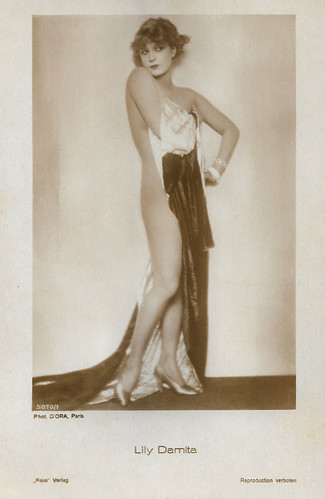
German postcard by Ross-Verlag, Berlin, no. 5070/1, 1930-1931. Photo: d'Ora, Paris.
Beautiful and seductive French actress Lily Damita (1902-1994) appeared in 33 French, Austrian, and Hollywood films between 1922 and 1937. Her marriage with Errol Flynn was rather tempestuous and led to her nickname 'Dynamita'.
Dora Philippine Kallmus was born in 1881 in Vienna, Austria. She came from a wealthy Jewish family. Her father Dr. Philipp Kallmus was a respected law attorney. Her mother died early and so she and her sister Anna were brought up by her grandmother and a governess.
Dora's first career aspiration was to become an actress. Because this job was not very well regarded in her family, she decided to become a milliner or tailor. On a trip to France, she discovered photography and decided to become a photographer.
Her family tolerated this plan more than her previous career plans, but there was another obstacle. As a woman, she was not allowed to attend a photography training. At that time women were denied a photography apprenticeship, but Dora Kallmus was allowed to work in the summer studio of the society photographer Hans Makart.
By an exemption, she could also attend the theoretical lectures of the at the Graphische Lehr- und Versuchsanstalt (Graphic Training Institute). However, she was not authorised to visit the practical seminars. Dora Kallmus: “It was found sufficient that I was the first woman to be allowed access to the lectures, but the chemical reagents were kept away from me as if they were indecent jokes.”
In 1905, she became a member of the Association of Austrian photographers. It was through the mediation of her uncle and financial support from her father that she was able to train for a few months in 1907 with the famous photographer Nicola Perscheid in Berlin. Perscheid described her as his "best student so far".
After her internship was over, Perscheid offered to keep her as an employee in his studio, but Dora Kallmus wanted to become self-employed. From then on, Kallmus worked under the pseudonym 'Madame d'Ora'.
She returned to Vienna and founded her own studio, Atelier d'Ora. During her training in Berlin, she had met Arthur Benda, Perscheid's first assistant, and brought him with her to Vienna.
Arthur Benda was born in Berlin in 1885. He worked as an assistant for Nicola Perscheid from 1906 to 1907. Benda became the technical manager of Atelier d'Ora and from 1922 on, they ran the studio together.

German postcard by NPG (Neue Photographische Geselschaft), no. 1116. Photo: d'Ora, Wien.
Actress Magda Sonja (1895-1974) was one of the divas of the Austrian silent cinema. She often starred in the films of her famous husband, actor and director Friedrich Feher.
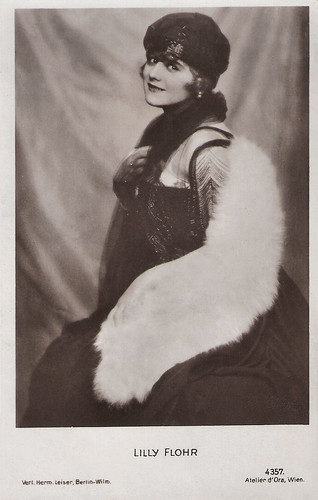
German postcard by Verlag Hermann Leiser, Berlin, no. 4357. Photo: Atelier d'Ora, Wien.
Austrian film star Lilly Flohr (1893-1978) was a busy actress, soubrette, cabaret artist, and chanson singer on stage. From 1918 on she starred in 25 silent films.

Austrian postcard by Iris Verlag, no. 804. Photo: d'Ora.
Hungarian Maria Corda (1898-1975) was an immensely popular star of the silent cinema of Austria and Germany. The pretty, blonde actress was a queen of the popular epic spectacles of the 1920s, which were often directed by her husband, Alexander Korda.
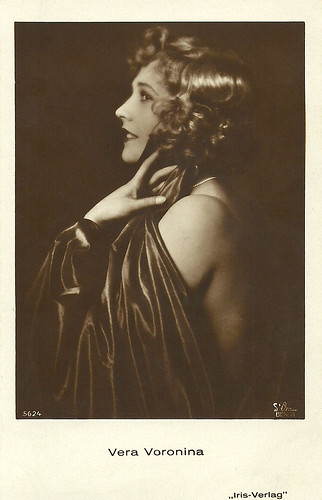
Austrian postcard by Iris Verlag, no. 5624. Photo: d'Ora / Arthur Benda. Collection: Didier Hanson.
Ukrainian actress Vera Voronina (1905-?) had a short but shining career in the late silent era, in Berlin as well as in Hollywood.
Atelier d’Ora soon gained a foothold in Viennese society. This success was probably partly due to the social ties that Dora Kallmus cultivated. Among the customers were the Austro-Hungarian aristocracy, rich industrialists, and politicians, but also such artists, actors, and writers as Gustav Klimt, Arthur Schnitzler, Marlene Dietrich, Oskar Kokoschka, Anna Sacher, Franz Werfel, and Richard Strauss.
D’Ora quickly was much in demand, especially for its society portraits, fashion photographs, and actor shots. It became chic to be portrayed by d’Ora. With her photographs, Madame d'Ora distinguished herself from the usually frozen portrait poses and looked for new, individual image solutions that matched the portrayed persons.
In addition to being a portrait studio for Viennese society, the Atelier d’Ora was also in high demand for its fashion shots. Designs of the Wiener Werkstätte were also photographed here. Many of the portraits and fashion photographs have been published in newspapers and magazines.
Atelier d’Ora was a commercial photo studio, but Madame d’Ora paid great importance to the artistic demands of her photographs and her studio. She strove for the recognition of her studio as an artistic photo studio. So she tried that to implement principles of pictorial photography and to create images as independent works of art could be viewed.
After the First World War, however, Vienna was no longer the centre of a world power, but only the capital of a small impoverished country. In the summer of 1921, d'Ora and Benda relocated their studio to the fashionable health resort Karlsbad (now Karlovy Vary). There, they worked during the summer months at the Olympic Palace Hotel. From 1921 to 1926 they were very successful there.
Possibly inspired by the French clientele that d’Ora found in Karlovy Vary, she decided to set up a second studio in Paris. In 1925, together with Benda, she opened the Parisian studio in rue Flachard in the 17th arrondissement. But Benda was not able to settle in Paris, their collaboration failed and Benda returned to Vienna.

Austrian postcard by Iris Verlag, no. 640-1. Photo: d'Ora.

Austrian postcard by Iris Verlag, no. 640-2. Photo d'Ora.

German postcard by Ross Verlag, no. 994/3, 1925-1926. Photo: d'Ora, Vienna.
In spite of her French name, Lucy Doraine (1898-1989) was a major Hungarian actress in the Austrian and German cinema in the 1920s. When she moved to Hollywood, the revolution of the sound film finished her career.

German postcard by Ross Verlag, no. 4077/1, 1929-1930. Photo: d'Ora, Wien / Arthur Benda.
German singer/actress Charlotte Ander (1902-1969) was a star in the silent era before making the transition to sound. The Nazis broke her successful career because she was not of 'pure blood'.
In 1927, Madame d’Ora remained in Paris to continue her studio there. Arthur Benda took over the studio in Vienna, replaced d’Ora's share and it came to a long, violent legal dispute over the name of the Vienna studio.
After a long time, it was agreed that Benda had to add his name in Vienna. The studio would now bear the name 'd’Ora-Benda-Vienna' and the Paris studio operated under the name 'd’Ora-Paris'. From the Second World War on, Benda ran the Vienna studio only under his name.
Arthur Benda stayed in Vienna for the rest of his life and became one of the most respected studio photographers and colour technology pioneers. He retired in 1965, and four years later he died of a stroke.
In Paris, Dora Kallmus managed to establish herself a second time and again attracted celebrities for her studio. Among d’Ora's Parisian clientele were again famous dancers, actors, painters, writers, and upper-class ladies. d'Ora portrayed such celebrities as Josephine Baker, Coco Chanel, Anna Pawlowa, Tamara de Lempicka, Alban Berg, Colette, and Maurice Chevalier.
Her photographs changed in terms of the contemporary taste of art and fashion. They became softer and more fluid in the transitions. Carefully elaborated light and glitter effects gave her pictures a glamour effect that was characteristic of this period.
During the Second World War, Dora Kallmus fled to the south of France. After the war, her photographs, her working methods, and their topics changed. In 1945, she travelled to Austria and took photos in a refugee camp where she documented the grief and displacement of the refugees. She reopened her studio in Paris and again made photographs of artists, and did numerous fashion shoots.
Her last significant work is a series of animal carcasses in Paris slaughterhouses from 1956. Kallmus made countless photos of killed, cut, and skinned animal carcasses and documented the consequences of mass slaughter.
After a serious traffic accident in Paris in 1959, Dora Kallmus was no longer able to work. In 1961 she returned to Austria in need of care. At her request, she spent her last years in Frohnleiten in Styria in her family's house. Madame d’Ora died there in 1963.
In the last decade, Madame d'Ora has been rediscovered. Her work was shown in three major exhibitions in Austria: 'Vienna's Shooting Girls – Jüdische Fotografinnen aus Wien' (2012-2013) in the Jewish Museum Vienna, 'Madame d’Ora. Machen Sie mich schön!' (2018) in the Leopold Museum, Vienna, and 'Der große Bruch: d'Oras Spätwerk' (2019-2020) in the GrazMuseum in Graz, Austria.
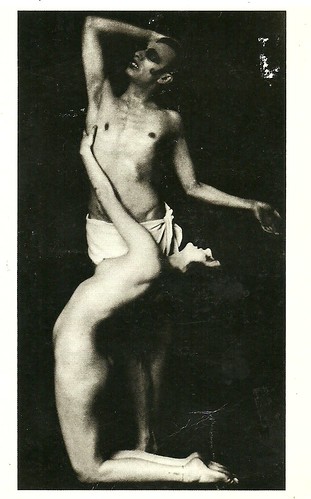
Vintage postcard. Photo: d'Ora, 1923. Collection: Didier Hanson. Photo for 'Dances of Vice, Horror, & Ecstasy' written and danced by Anita Berber and Sebastian Droste.
Expressionistic dancer and film actress Anita Berber (1899–1928) challenged many taboos during the Weimar period. With her drug and booze addiction and her bisexual affairs, she epitomised the decadence of 1920s Berlin. Her charcoaled eyes, her black lipstick, and bright red, bobbed hair were featured on a famous portrait of her by Otto Dix and in silent films by Richard Oswald and Fritz Lang.
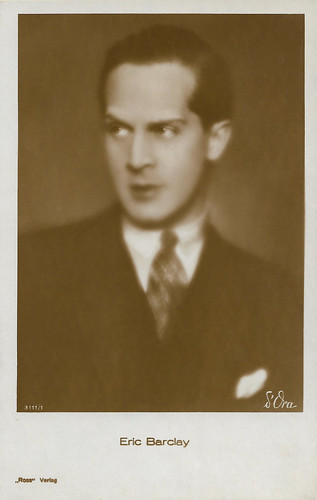
German postcard by Ross Verlag, no. 3111/1, 1928-1929. Photo: d'Ora.
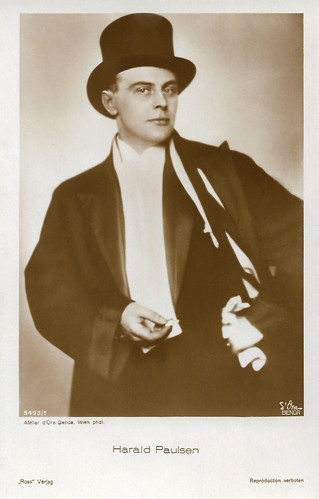
German postcard by Ross Verlag, no. 5493/1, 1930-1931. photo: Atelier d'Ora Benda, Wien.
Fast-talking German actor Harald Paulsen (1895-1954) appeared in 125 films between 1920 and 1954, including Robert Wiene's Genuine (1920) and Alraune (1930) with Brigitte Helm. He was on stage from 1913 and an ensemble member of Max Reinhardt's Deutsche Theater in the 1920s. Paulsen also played Mack the Knife in the original cast of 'Die Dreigroschenoper' (The Threepenny Opera) written by Kurt Weill and Bertolt Brecht. The show's opening number, 'Mack the Knife', became the most popular song of its time.

German postcard by Ross Verlag / Das Programm von Heute für Film und Theater. Photo: d'Ora. Paris.
Madeleine Renaud (1900-1994) was an acclaimed French stage actress, who also had a career in film. One of her best-known films was La Maternelle (1933).
Sources: Sophie Dorothée Vitovec (Anita Berber im fotografischen Blick von Madame d’Ora - German), Wikipedia and Luminous Lint.

Small French card by Columbia. Photo: d'Ora.
Josephine Baker (1906-1975) was well-known as a singer and dancer. In 1925 she became an instant success in Paris, because of her erotic dance. She also performed in a handful of silent and early sound films, La Sirene des Tropiques (1927), Zouzou (1934), and La princesse TamTam (1935).

Austrian postcard by Iris Verlag, no. 994. Photo: d'Ora.
Eric Barclay (1894-1938) was a Swedish film actor. Barclay became a prominent actor in French silent films of the early 1920s, often working with director Jacques de Baroncelli. He also appeared in German and British films and those of his native Sweden.

German postcard by Ross Verlag, no. 3264/1, 1928-1929. Photo: d'Ora / Arthur Benda.
Marlene Dietrich (1901-1992) is regarded as the first German actress to become successful in Hollywood. Throughout her long career, she constantly re-invented herself, starting as a cabaret singer, chorus girl and film actress in 1920s Berlin, she became a Hollywood movie star in the 1930s, a World War II frontline entertainer, and finally an international stage show performer from the 1950s to the 1970s, eventually becoming one of the entertainment icons of the 20th century.

German postcard by Ross-Verlag, Berlin, no. 5070/1, 1930-1931. Photo: d'Ora, Paris.
Beautiful and seductive French actress Lily Damita (1902-1994) appeared in 33 French, Austrian, and Hollywood films between 1922 and 1937. Her marriage with Errol Flynn was rather tempestuous and led to her nickname 'Dynamita'.
Indecent jokes
Dora Philippine Kallmus was born in 1881 in Vienna, Austria. She came from a wealthy Jewish family. Her father Dr. Philipp Kallmus was a respected law attorney. Her mother died early and so she and her sister Anna were brought up by her grandmother and a governess.
Dora's first career aspiration was to become an actress. Because this job was not very well regarded in her family, she decided to become a milliner or tailor. On a trip to France, she discovered photography and decided to become a photographer.
Her family tolerated this plan more than her previous career plans, but there was another obstacle. As a woman, she was not allowed to attend a photography training. At that time women were denied a photography apprenticeship, but Dora Kallmus was allowed to work in the summer studio of the society photographer Hans Makart.
By an exemption, she could also attend the theoretical lectures of the at the Graphische Lehr- und Versuchsanstalt (Graphic Training Institute). However, she was not authorised to visit the practical seminars. Dora Kallmus: “It was found sufficient that I was the first woman to be allowed access to the lectures, but the chemical reagents were kept away from me as if they were indecent jokes.”
In 1905, she became a member of the Association of Austrian photographers. It was through the mediation of her uncle and financial support from her father that she was able to train for a few months in 1907 with the famous photographer Nicola Perscheid in Berlin. Perscheid described her as his "best student so far".
After her internship was over, Perscheid offered to keep her as an employee in his studio, but Dora Kallmus wanted to become self-employed. From then on, Kallmus worked under the pseudonym 'Madame d'Ora'.
She returned to Vienna and founded her own studio, Atelier d'Ora. During her training in Berlin, she had met Arthur Benda, Perscheid's first assistant, and brought him with her to Vienna.
Arthur Benda was born in Berlin in 1885. He worked as an assistant for Nicola Perscheid from 1906 to 1907. Benda became the technical manager of Atelier d'Ora and from 1922 on, they ran the studio together.

German postcard by NPG (Neue Photographische Geselschaft), no. 1116. Photo: d'Ora, Wien.
Actress Magda Sonja (1895-1974) was one of the divas of the Austrian silent cinema. She often starred in the films of her famous husband, actor and director Friedrich Feher.

German postcard by Verlag Hermann Leiser, Berlin, no. 4357. Photo: Atelier d'Ora, Wien.
Austrian film star Lilly Flohr (1893-1978) was a busy actress, soubrette, cabaret artist, and chanson singer on stage. From 1918 on she starred in 25 silent films.

Austrian postcard by Iris Verlag, no. 804. Photo: d'Ora.
Hungarian Maria Corda (1898-1975) was an immensely popular star of the silent cinema of Austria and Germany. The pretty, blonde actress was a queen of the popular epic spectacles of the 1920s, which were often directed by her husband, Alexander Korda.

Austrian postcard by Iris Verlag, no. 5624. Photo: d'Ora / Arthur Benda. Collection: Didier Hanson.
Ukrainian actress Vera Voronina (1905-?) had a short but shining career in the late silent era, in Berlin as well as in Hollywood.
No frozen portrait poses
Atelier d’Ora soon gained a foothold in Viennese society. This success was probably partly due to the social ties that Dora Kallmus cultivated. Among the customers were the Austro-Hungarian aristocracy, rich industrialists, and politicians, but also such artists, actors, and writers as Gustav Klimt, Arthur Schnitzler, Marlene Dietrich, Oskar Kokoschka, Anna Sacher, Franz Werfel, and Richard Strauss.
D’Ora quickly was much in demand, especially for its society portraits, fashion photographs, and actor shots. It became chic to be portrayed by d’Ora. With her photographs, Madame d'Ora distinguished herself from the usually frozen portrait poses and looked for new, individual image solutions that matched the portrayed persons.
In addition to being a portrait studio for Viennese society, the Atelier d’Ora was also in high demand for its fashion shots. Designs of the Wiener Werkstätte were also photographed here. Many of the portraits and fashion photographs have been published in newspapers and magazines.
Atelier d’Ora was a commercial photo studio, but Madame d’Ora paid great importance to the artistic demands of her photographs and her studio. She strove for the recognition of her studio as an artistic photo studio. So she tried that to implement principles of pictorial photography and to create images as independent works of art could be viewed.
After the First World War, however, Vienna was no longer the centre of a world power, but only the capital of a small impoverished country. In the summer of 1921, d'Ora and Benda relocated their studio to the fashionable health resort Karlsbad (now Karlovy Vary). There, they worked during the summer months at the Olympic Palace Hotel. From 1921 to 1926 they were very successful there.
Possibly inspired by the French clientele that d’Ora found in Karlovy Vary, she decided to set up a second studio in Paris. In 1925, together with Benda, she opened the Parisian studio in rue Flachard in the 17th arrondissement. But Benda was not able to settle in Paris, their collaboration failed and Benda returned to Vienna.

Austrian postcard by Iris Verlag, no. 640-1. Photo: d'Ora.

Austrian postcard by Iris Verlag, no. 640-2. Photo d'Ora.

German postcard by Ross Verlag, no. 994/3, 1925-1926. Photo: d'Ora, Vienna.
In spite of her French name, Lucy Doraine (1898-1989) was a major Hungarian actress in the Austrian and German cinema in the 1920s. When she moved to Hollywood, the revolution of the sound film finished her career.

German postcard by Ross Verlag, no. 4077/1, 1929-1930. Photo: d'Ora, Wien / Arthur Benda.
German singer/actress Charlotte Ander (1902-1969) was a star in the silent era before making the transition to sound. The Nazis broke her successful career because she was not of 'pure blood'.
A long, violent legal dispute
In 1927, Madame d’Ora remained in Paris to continue her studio there. Arthur Benda took over the studio in Vienna, replaced d’Ora's share and it came to a long, violent legal dispute over the name of the Vienna studio.
After a long time, it was agreed that Benda had to add his name in Vienna. The studio would now bear the name 'd’Ora-Benda-Vienna' and the Paris studio operated under the name 'd’Ora-Paris'. From the Second World War on, Benda ran the Vienna studio only under his name.
Arthur Benda stayed in Vienna for the rest of his life and became one of the most respected studio photographers and colour technology pioneers. He retired in 1965, and four years later he died of a stroke.
In Paris, Dora Kallmus managed to establish herself a second time and again attracted celebrities for her studio. Among d’Ora's Parisian clientele were again famous dancers, actors, painters, writers, and upper-class ladies. d'Ora portrayed such celebrities as Josephine Baker, Coco Chanel, Anna Pawlowa, Tamara de Lempicka, Alban Berg, Colette, and Maurice Chevalier.
Her photographs changed in terms of the contemporary taste of art and fashion. They became softer and more fluid in the transitions. Carefully elaborated light and glitter effects gave her pictures a glamour effect that was characteristic of this period.
During the Second World War, Dora Kallmus fled to the south of France. After the war, her photographs, her working methods, and their topics changed. In 1945, she travelled to Austria and took photos in a refugee camp where she documented the grief and displacement of the refugees. She reopened her studio in Paris and again made photographs of artists, and did numerous fashion shoots.
Her last significant work is a series of animal carcasses in Paris slaughterhouses from 1956. Kallmus made countless photos of killed, cut, and skinned animal carcasses and documented the consequences of mass slaughter.
After a serious traffic accident in Paris in 1959, Dora Kallmus was no longer able to work. In 1961 she returned to Austria in need of care. At her request, she spent her last years in Frohnleiten in Styria in her family's house. Madame d’Ora died there in 1963.
In the last decade, Madame d'Ora has been rediscovered. Her work was shown in three major exhibitions in Austria: 'Vienna's Shooting Girls – Jüdische Fotografinnen aus Wien' (2012-2013) in the Jewish Museum Vienna, 'Madame d’Ora. Machen Sie mich schön!' (2018) in the Leopold Museum, Vienna, and 'Der große Bruch: d'Oras Spätwerk' (2019-2020) in the GrazMuseum in Graz, Austria.

Vintage postcard. Photo: d'Ora, 1923. Collection: Didier Hanson. Photo for 'Dances of Vice, Horror, & Ecstasy' written and danced by Anita Berber and Sebastian Droste.
Expressionistic dancer and film actress Anita Berber (1899–1928) challenged many taboos during the Weimar period. With her drug and booze addiction and her bisexual affairs, she epitomised the decadence of 1920s Berlin. Her charcoaled eyes, her black lipstick, and bright red, bobbed hair were featured on a famous portrait of her by Otto Dix and in silent films by Richard Oswald and Fritz Lang.

German postcard by Ross Verlag, no. 3111/1, 1928-1929. Photo: d'Ora.

German postcard by Ross Verlag, no. 5493/1, 1930-1931. photo: Atelier d'Ora Benda, Wien.
Fast-talking German actor Harald Paulsen (1895-1954) appeared in 125 films between 1920 and 1954, including Robert Wiene's Genuine (1920) and Alraune (1930) with Brigitte Helm. He was on stage from 1913 and an ensemble member of Max Reinhardt's Deutsche Theater in the 1920s. Paulsen also played Mack the Knife in the original cast of 'Die Dreigroschenoper' (The Threepenny Opera) written by Kurt Weill and Bertolt Brecht. The show's opening number, 'Mack the Knife', became the most popular song of its time.

German postcard by Ross Verlag / Das Programm von Heute für Film und Theater. Photo: d'Ora. Paris.
Madeleine Renaud (1900-1994) was an acclaimed French stage actress, who also had a career in film. One of her best-known films was La Maternelle (1933).
Sources: Sophie Dorothée Vitovec (Anita Berber im fotografischen Blick von Madame d’Ora - German), Wikipedia and Luminous Lint.
No comments:
Post a Comment